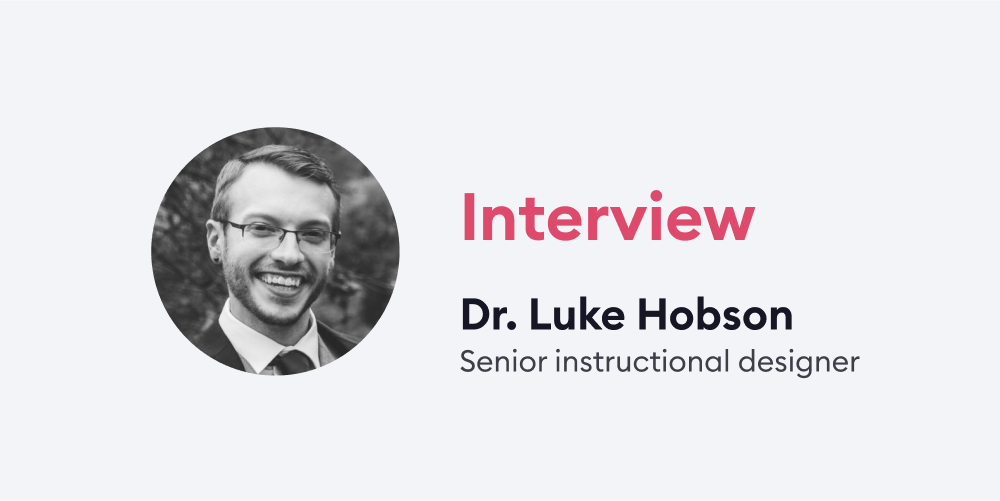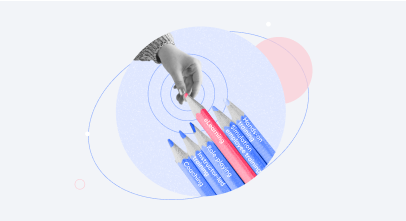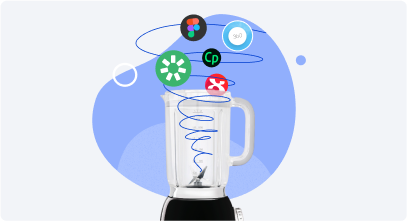The Interview with Dr. Luke Hobson: From Hating School to Becoming a Senior Instructional Designer

Dr. Luke Hobson is a senior instructional designer and program manager at the Massachusetts Institute of Technology (MIT). Ironically, his way to success started from hating education and even flunking out of high school. Back then, he didn’t understand why he should study math or physics because nobody showed him the goal. This experience gave Dr. Luke Hobson a valuable perspective on how to teach people, how to motivate them, and succeed even with such difficult students as himself.
We talked to Dr. Hobson about his new book What I Wish I Knew Before Becoming An Instructional Designer, discussed how to become an instructional designer, the pros and cons of this profession, the difference between the academic and corporate ID, and much more – including the most important tips that might help you achieve success. You can watch our full interview, or read the main takeaways below.
What does an instructional designer do?
When people ask me what I do for a career, I usually say: I understand how people learn online. I work in partnership with SMEs and extract knowledge from them. And then, taking what I know about learning sciences, I develop an online learning experience that’s going to become meaningful, but also transparent to my students. I make sure they understand why they’re learning how they’re going to go through this process. So that, to me, is instructional design in a nutshell.
Can anyone become an instructional designer?
Yes and no. Because, yes, anyone can, in theory, become an instructional designer, in the same way that you can be anything you want to be when you grow up. But there are a few important things that it takes:
- Passion. This field of education requires lots of it.
- Understanding your role. You’re not a teacher. You’re not an administrator. You’re kind of behind the scenes and, at the same time, you’re not.
- Experience. You need a considerable amount of experience to design engaging learning.
When people learn that I’m from MIT, they think I must be a super genius. No. I’m just somebody who has worked hard.

The Massachusetts Institute of Technology
What is your favorite part of being an instructional designer?
Being able to have that level of a significant difference in someone’s life. A person once decided to change her career after my course. It introduced her to this whole new world, and she had no idea it was her passion. All of a sudden, she realized that she wanted to do this for the rest of her life. We usually think that our courses will just help people a little bit, develop their skills and knowledge. But no – we can have a drastic effect on someone’s life. And that is so cool.
What is your least favorite part of being an instructional designer?
Learning how to encounter the word ‘No’ and find ways around that. You might be thinking that you know what’s best for the students, as you are the one designing the course. But at the same time, when you’re working with a subject matter expert, they’re probably thinking the exact same thing. Sometimes you need to be able to meet in the middle. And sometimes that just doesn’t exist. There is no middle ground. You are on completely opposite sides of a story. And you need to figure out how to get around the problem when nobody is happy. Because, even though you might think instructional design is going to be an individual type of position, that’s not true at all. It is very team based. And you have to try to be able to handle different types of conflicts and find resolutions that are going to work for everybody.
If you could go back in time and give your earlier self advice about instructional design, what would it be?
It would definitely be about working with subject matter experts. I did not realize just how involved I’ll be working with these folks. At the same time, there are some projects where you’re working with up to many – 3, 4, 5, or 6 – people, all depending on the project.
Let’s say you have an SME who is a representative of higher education: an instructor or a dean, or someone along those lines. But then you’re also developing and trying to make sure you’re getting fair representation from the industry. Well, then, you have SMEs who are actually in the field, they’re working in the manufacturing plants. They are the ones who are literally the ‘boots on the ground.’ And you need to be able to work with those folks as well, and then figure out how you are going to put all of these thoughts together when they don’t necessarily align.
Being able to have a lot of human skills is really what I would say I wish I knew about, because I would have focused on developing different skill sets.
Whenever someone is talking to me about becoming an instructional designer, they immediately go into talking about using only tools or only talking about learning theories. That’s great, it’s a part of it, but I guarantee that most of the process is working with people. And you need to work on those skills before anything else.
What other advice do you have for instructional design beginners?
- Work with folks more, and step outside of your comfort zone. You shouldn’t be afraid of this experience, but embrace it and make the most out of it.
- Don’t be afraid of the fact that you don’t have all the answers. You can admit that you don’t know. You have the opportunity to go and find out. Connect with others, and then go and bring that back.
- Be a lifelong learner, enjoy learning, enjoy teaching yourself. If you don’t enjoy learning new things, then this role is not for you.
How is ID in the corporate world different from that in higher education?
There are some differences, but there are a lot of similarities too. Because, at the end of the day, we still do the same type of thing. We have instructional design models. We know about learning. We are creative thinkers. We are problem solvers.
A lot of the time, differences come down to these questions:
- How long do you actually have to work on a project?
- What are the resources?
- What’s the budget?
But the biggest difference, in my opinion, would be that, for higher education, you’re going to be training students, and, within the corporate world, employees.
If your passion is that you want to be able to go and develop the new workforce and try to make them the very best they can possibly be, and then go and lead this charge for whatever is coming next within whatever particular field you’re going to be working in, then corporate ID is right for you.

Luke Hobson with his wife
And the flip side, if you love education and your passion is that you love students and being able to see them grow as far as possible in the classroom, and trying to help them along their academic journey, then follow academic ID. The main question is “What do you find meaningful?”
Do you think that motivation for a student and a corporate worker is different?
Absolutely. You need to find what motivates your particular learners. For example, some employees will always dislike the idea of mandatory training. But if you’re going to have some program, say, for leadership, where if somebody knows that they’re going to be taking a program that by the time they’re done, they’ll get a certificate, and in the eyes of their employer, they will be more likely to receive a promotion, then, clearly, the motivation is going to be very different.
One of the ways to motivate students is really to be able to give more real-world examples of how actual companies had a problem, they figured out how to solve it, and here’s the method that they used – and hey, you can replicate that.
The same thing goes when it comes to students. If you have students who are taking a course in their major and they love whatever subject matter you’re talking about, then obviously they’re going to be really jazzed about it and they’ll want to take this course. Unlike if you’re going to be forcing somebody to go and take an economics course because they have to, it’s a part of their bachelor’s degree. They’re probably not going to enjoy it.
So, no matter whether it’s the higher education or corporate field, you can inspire a student or a learner to take the course and be successful?
Yes. Make sure your learners can answer these questions:
- If I take this, what am I going to be learning about?
- How is this going to help me?
We have all taken a course where there are 10 learning outcomes, and none of them match what you’re going to be talking about. Just explain in basic words: “OK, you’re taking this, and in the end, you’re going to walk away with this scale, this one, and this one, this is how it’s going to help you.” If you don’t show the end goal, it’s just like with anything else in life, you don’t follow through.
Imagine that we are putting together a starter kit for an instructional designer. What resources can we put there?
I have so many answers to this question. For example, here are some of my favorite books on instructional design:
- Design for How People Learn, by Julie Dirksen
- eLearning Design Handbook, by Tim Slade
- UDL in the Cloud, by Dr. Katie Novak and Tom Thibodeau
- UDL and Blended Learning: Thriving in Flexible Learning Landscapes, by Dr. Katie Novak and Dr. Catlin Tucker
There are a thousand other different resources you can go to, from podcasts, YouTube videos, to… you name it. And I think that’s starting to become a problem. We have so many resources that, right now, if you just google instructional design resources, a thousand are going to pop up. The one thing that I would just beg you to do is don’t just go and buy five books, or watch like 20 YouTube videos. You need to be able to take action.
During your career as an instructional designer, have you noticed changes in how people are consuming the information, how they learn, so that you now have to change the way you are building the content or the training courses?
Yes. Things are changing. Things are going to be changing even more rapidly now that we are coming out of this post-pandemic world where people have been introduced to every single type of media as far as what they wanted to be able to do.
For instance, people now more than ever are turning to podcasts. And you need to meet your learners where they are. If they’re going to consume podcasts, well, guess what? You’re making podcasts. It’s that simple. If you have students who are obsessed with games, look at gamification. If you have students who are going to be doing something that, in the real world, will almost require an extra level of preparation before diving into there, then it’s time to start looking at simulations and trying to figure out how you can help them out.
Can you make some predictions about the future of eLearning?
My overall guess is that the courses are going to be more about the students. They’re going to be more student-centric for everything. We’re going to be designing the types of online courses with them in mind more than ever.

Luke Skywalker Hobson bringing hope to the galaxy of instructional design
There’s a new thing – a VTuber. This is essentially a virtual YouTuber. Instead of them being on camera, there is something else that has a virtual image of themselves, who is the one that’s doing the talking. And we have enough tools out there that are sophisticated enough to actually be able to monitor and see what they’re doing for the mannerisms. And then to be able to replicate that on screen. And perhaps it’s going to be a cutesy little animal or a 3D version of themselves or an animated character.
So, what if we gave the option to make students more comfortable on camera by allowing them to not really technically be on camera and have a different representation of themselves? That way, the instructor doesn’t feel like they’re talking to a bunch of black screens on Zoom, but now they’re actually being able to focus on something and still interact with them.
I bet we’re going to make learners more comfortable by using VR and XR. There’s a ton of them that do exist that work for anyone’s budget and what, in particular, they want to do and what they don’t. But I bet that’s what we’re going to do, especially for younger students, for kids in K-12. You don’t want to be on camera all day. It’s just awful for the kids. So, I bet we’re going to look at that closely going forward.
What is the course you are most proud of?
I really did enjoy building an entire series of leadership courses at MIT. We made them specifically for leadership in engineering. So, it was a different take on leadership because you have a lot of folks in engineering who see management in a negative light.
It was really interesting trying to build those programs and then being able to see the results of those, tell these folks more about culture and networking, talk about business strategies, and how to actually innovate in the real world.
We were able to see folks communicate with each other. And they didn’t realize that they were actually in the course together. So, what I mean by that – because it sounds super confusing – is that we had the same organization send the learners through a program, but they were at different locations. And then, within some of the collaborative tools, like using peer-reviewed assessments, and then moving over into the discussion boards, they realized that they were trying to solve the same problem, but at different locations. So, they use the content of the course to try to figure out: “How do we solve the problem?”
And then they did. It actually helped solve a problem for this well-known organization within their department. But that was so cool to see people come together using what we created and seeing the fruits of their labor, of how that all came together.
Can you name the most important thing every instructional designer or future instructional designer should do right after this conversation to take one step further on their career path?
You need to go on LinkedIn and network with other instructional designers. Surround yourself with other people in the field because it is true that your inner circle influences you.
You should be able to get feedback from people you respect and admire and who know what they’re talking about. And by networking, you can bring those people into your inner circle. So, find knowledgeable people, bring them in, and then guess what? You are a new instructional designer out there. And the people who post instructional design jobs are hiring on their own team. And they’re going to post a job before anyone, before the organization. They’ll give you a heads-up.
So, connect with others, feel free to add me if you want to. I post a lot of instructional design content, as you would probably assume. So, that is the one step you should take right now: go to your LinkedIn profile, start networking with other people, Search for instructional designers, find them, add them, talk to them, treat them like real human beings, and just watch how these relationships will help you out in your career.
These are the takeaways from our interview with Dr. Luke Hobson. If you would like to hear the entire conversation, check out our podcast for instructional designers. To learn more insights from Dr. Hobson, check out his YouTube channel and new book What I Wish I Knew Before Becoming An Instructional Designer that is available online. Stay tuned for more inspiring conversations. Good luck!









